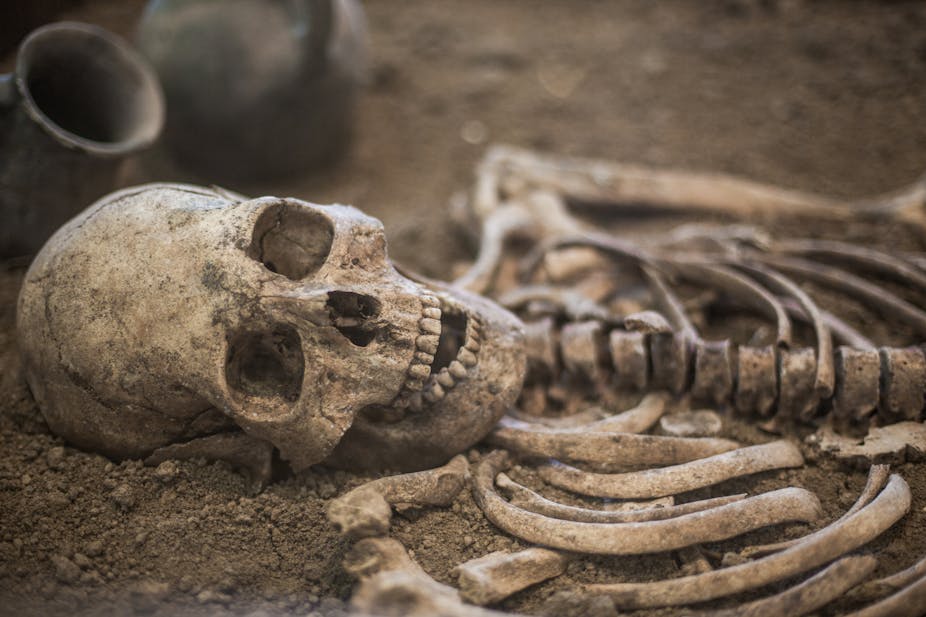Dating is everything in archaeology. Exciting discoveries of ancient burial sites or jewellery might make headlines, but for scientists, this kind of discovery is only meaningful if we can tell how old the artefacts are.
So when chemist Willard Libby developed radiocarbon dating in 1946, it was a breakthrough for archaeology and he was awarded a Nobel prize for his achievement.
Nowadays people take radiocarbon technology for granted and many people think you can use radiocarbon on any human remains. Scientists wish that was true, but in reality, only 50% of corpses can be dated using this method because in some skeletons there isn’t enough organic material or it is contaminated.
Many exciting finds have been inaccurately dated or not dated at all, meaning the skeletons’ clues from the past are still locked away. But my team may have found the key: DNA dating.
How radiocarbon dating works
To understand why we need DNA dating, you need to know what radiocarbon dating is. It allows us to date organic material (that is younger than 50,000 years) based on the chemical reactions that the body exchanges with the environment after death.
Carbon is found in all living things and is the backbone of all molecules. We absorb it when we eat food and exhale it into the atmosphere. Radiocarbon dating compares the three different isotopes (a type of atom) of carbon.
The most abundant, carbon-12, remains stable in the atmosphere. It’s a good yardstick to measure the age of skeletons as one of the other isotopes, carbon-14 is radioactive and decays over time.
Since animals and plants stop absorbing carbon-14 when they decay, the radioactivity of the carbon-14 that’s left behind reveals their age. But there’s a catch. Low amounts of organic material, the diet of the dead person or animal, and contamination with modern samples can skew the calculation.
Variation in dating between labs alone can be up to 1,000 years. It is like dating Queen Elizabeth II to William the Conqueror’s time.

The alternative to radiocarbon dating is using archaeological artefacts found alongside human remains. This works if we find a skeleton carrying a coin minted by Julius Caesar, say. But that rarely happens.
The earliest human remains in Afghanistan were found in the Darra-i-Kur cave in Badakhshan. They were initially assumed to be from the Paleolitihc era (30,000 years before the present), based on radiocarbon dating of charcoal and soil samples. But a later study measured skull fragments found in the cave against modern human skulls and realised it was closer to modern human form than Neanderthal. The skull fragment was radiocarbon dated to the Neolithic, some 25,000 years later. The mistake was due to inadequate carbon samples. It was the first ancient human from Afghanistan to have their DNA sequenced.
A new dating tool
Scientists already know of DNA mutations that can show where someone was from. My team created a “GPS” tool for genomes that helped us to identify Ancient Ashkenaz as the birthplace of Ashkenazi Jews and the Yiddish language. There are also DNA mutations that help tell us how long ago someone lived.
One example is the LCT gene mutation that allowed our ancestors to process lactose. It has increased rapidly since it first emerged developed in the Neolithic era (10,000-8,000 BC). So we can date ancient genomes without the LCT gene mutation to before the Neolithic era.
My team developed the temporal population structure (TPS) algorithm tool and used it to date 5,000 ancient and modern genomes. There are tens of thousands of mutations that increased or decreased over time. TPS identifies these mutations and the period they are associated with and classifies them into eight broad periods.
Each ancient person is represented by the signatures of these periods. TPS uses a type of artificial intelligence known as supervised machine learning to match those signatures to the ages of skeletons.
One way to test a dating method is to compare the age gap of skeletons that are related to each other. This can work well if the skeletons are complete enough to estimate their age. You would expect father and son skeletons, for example, to be dated to a period of about 17 to 35 years apart.
In a blind test, the TPS dated the skeletons of close family members within a sensible time span of 17 years apart, compared with 68 years in a non-blind test for other dating methods. (A blind test is when information that can influence the experimenters is withheld until the experiment is complete.)
One of the most controversial sites for ancient dating is the Czechia Brandýsek burial site. The Brandýsek burials dated to the Bell Beaker period were explored between 1955 and 1956.
Archaeologists uncovered graves, half of which were destroyed by mining operations. They found 23 people from 22 graves alongside artefacts such as pottery, a bone pendant and flint arrowheads.
Based on both radiocarbon and archaeological context, the site was dated to the Bell Beaker period (4,800- 3,800 years ago). However, the same study radiocarbon dated one of the skeletons to around (5,500 years ago).
Given that only two corpses could be radiocarbon dated, it was difficult to tell whether the dating was wrong or if this was a site that may have had ritualistic importance for thousands of years. Our DNA study of 12 skeletons from the site confirmed the questionable skeleton was about 1,000 years older than the others.
Our results confirm that this site has been a burial ground since the Neolithic period. This also explains why the site has architectural features not usually associated with Bell Beaker burials, like stone graves.
While TPS performed well, it is not a substitute for radiocarbon dating. Its accuracy depends on a dataset of ancient DNA. TPS can set dates for human and farm animals, for which extensive ancient data is available. But those who want to travel to the past to meet an ancient elephant or a monkey are on their own.

